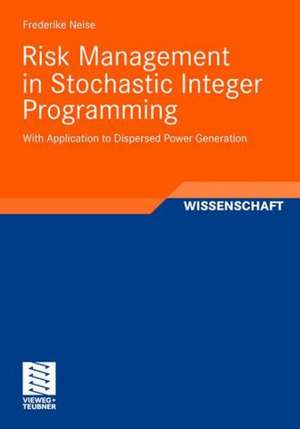Risk Management in Stochastic Integer Programming: With Application to Dispersed Power Generation
Autor Frederike Neiseen Limba Engleză Paperback – 28 iul 2008
Preț: 376.80 lei
Nou
Puncte Express: 565
Preț estimativ în valută:
72.11€ • 74.49$ • 60.01£
72.11€ • 74.49$ • 60.01£
Carte tipărită la comandă
Livrare economică 25 martie-08 aprilie
Preluare comenzi: 021 569.72.76
Specificații
ISBN-13: 9783834805478
ISBN-10: 3834805475
Pagini: 116
Ilustrații: VIII, 107 p.
Dimensiuni: 148 x 210 x 6 mm
Greutate: 0.15 kg
Ediția:2008
Editura: Vieweg+Teubner Verlag
Colecția Vieweg+Teubner Verlag
Locul publicării:Wiesbaden, Germany
ISBN-10: 3834805475
Pagini: 116
Ilustrații: VIII, 107 p.
Dimensiuni: 148 x 210 x 6 mm
Greutate: 0.15 kg
Ediția:2008
Editura: Vieweg+Teubner Verlag
Colecția Vieweg+Teubner Verlag
Locul publicării:Wiesbaden, Germany
Public țintă
ResearchCuprins
Risk Measures in Two-Stage Stochastic Programs.- Stochastic Dominance Constraints induced by Mixed-Integer Linear Recourse.- Application: Optimal Operation of a Dispersed Generation System.- Conclusion and Perspective.
Notă biografică
Dr. Frederike Neise gained a PhD in Mathematics from the University of Duisburg-Essen studying two-stage stochastic programming and its application to the optimal management of dispersed generation systems. She currently works as a gas market analyst with E.ON Ruhrgas AG.
Textul de pe ultima copertă
Two-stage stochastic optimization is a useful tool for making optimal decisions under uncertainty. Frederike Neise describes two concepts to handle the classic linear mixed-integer two-stage stochastic optimization problem: The well-known mean-risk modeling, which aims at finding a best solution in terms of expected costs and risk measures, and stochastic programming with first order dominance constraints that heads towards a decision dominating a given cost benchmark and optimizing an additional objective. For this new class of stochastic optimization problems results on structure and stability are proven. Moreover, the author develops equivalent deterministic formulations of the problem, which are efficiently solved by the presented dual decomposition method based on Lagrangian relaxation and branch-and-bound techniques. Finally, both approaches – mean-risk optimization and dominance constrained programming – are applied to find an optimal operation schedule for a dispersed generation system, a problem from energy industry that is substantially influenced by uncertainty.










